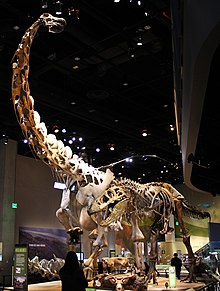| Alamosaurus Temporal range: Late Cretaceous (Maastrichtian),
| |
|---|---|

| |
| Restored skeletons of Alamosaurus and Tyrannosaurus at Perot Museum | |
| Scientific classification | |
| Domain: | Eukaryota |
| Kingdom: | Animalia |
| Phylum: | Chordata |
| Clade: | Dinosauria |
| Clade: | Saurischia |
| Clade: | †Sauropodomorpha |
| Clade: | †Sauropoda |
| Clade: | †Macronaria |
| Clade: | †Titanosauria |
| Family: | †Saltasauridae |
| Subfamily: | †Opisthocoelicaudiinae |
| Genus: | †Alamosaurus Gilmore, 1922 |
| Type species | |
| †Alamosaurus sanjuanensis Gilmore, 1922
| |
Alamosaurus (/ˌæləmoʊˈsɔːrəs/;[1] meaning "Ojo Alamo lizard") is a genus of titanosaurian sauropod dinosaurs containing a single known species, Alamosaurus sanjuanensis, from the Maastrichtian age of the Late Cretaceous period in what is now southwestern North America. It is the only known titanosaur to have inhabited North America after the nearly 30-million year absence of sauropods from the North American fossil record and probably represents an immigrant from South America.
Adults would have measured around 26 metres (85 ft) long, 5 metres (16 ft) tall at the shoulder and weighed up to 30–35 tonnes (33–39 short tons), though some specimens indicate a larger body size. Isolated vertebrae and limb bones suggest that it could have reached sizes comparable to Argentinosaurus and Puertasaurus, which would make it the absolute largest dinosaur known from North America.[2] Its fossils have been recovered from a variety of rock formations spanning the Maastrichtian age. Specimens of a juvenile Alamosaurus sanjuanensis have been recovered from only a few meters below the Cretaceous-Paleogene boundary in Texas, making it among the last surviving non-avian dinosaur species.[3]
- ^ "Alamosaurus". Lexico UK English Dictionary. Oxford University Press. Archived from the original on March 3, 2021.
- ^ Cite error: The named reference
DFRS11was invoked but never defined (see the help page). - ^ Cite error: The named reference
lehman-coulson-2002was invoked but never defined (see the help page).